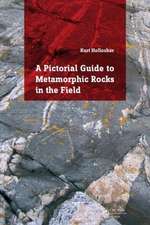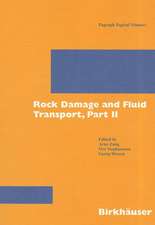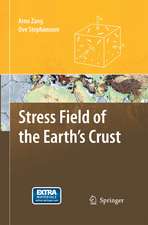Rock Damage and Fluid Transport, Part I: Pageoph Topical Volumes
Editat de G. Dresen, Ove Stephansson, Arno Zangen Limba Engleză Paperback – 18 iul 2006
Part I of this topical volume covers mainly the nucleation and evolution of crack damage in rocks, new or modified techniques to measure rock fracture toughness and a discussion of upscaling techniques relating mechanical and fluid transport behaviour in rocks at different spatial scales.
Part II, to be published later in 2006, will include studies investigating the coupling of rock deformation and fluid flow.
Din seria Pageoph Topical Volumes
-
 Preț: 300.85 lei
Preț: 300.85 lei -
 Preț: 386.19 lei
Preț: 386.19 lei -
 Preț: 303.07 lei
Preț: 303.07 lei -
 Preț: 306.14 lei
Preț: 306.14 lei - 15%
 Preț: 720.73 lei
Preț: 720.73 lei -
 Preț: 397.38 lei
Preț: 397.38 lei -
 Preț: 314.52 lei
Preț: 314.52 lei - 15%
 Preț: 641.71 lei
Preț: 641.71 lei -
 Preț: 221.70 lei
Preț: 221.70 lei -
 Preț: 328.35 lei
Preț: 328.35 lei - 15%
 Preț: 726.94 lei
Preț: 726.94 lei -
 Preț: 308.55 lei
Preț: 308.55 lei -
 Preț: 320.20 lei
Preț: 320.20 lei -
 Preț: 384.70 lei
Preț: 384.70 lei -
 Preț: 301.10 lei
Preț: 301.10 lei -
 Preț: 298.66 lei
Preț: 298.66 lei -
 Preț: 299.34 lei
Preț: 299.34 lei -
 Preț: 324.18 lei
Preț: 324.18 lei -
 Preț: 392.75 lei
Preț: 392.75 lei -
 Preț: 312.97 lei
Preț: 312.97 lei -
 Preț: 307.88 lei
Preț: 307.88 lei -
 Preț: 387.96 lei
Preț: 387.96 lei -
 Preț: 405.06 lei
Preț: 405.06 lei -
 Preț: 386.00 lei
Preț: 386.00 lei -
 Preț: 396.40 lei
Preț: 396.40 lei -
 Preț: 404.29 lei
Preț: 404.29 lei -
 Preț: 391.99 lei
Preț: 391.99 lei -
 Preț: 351.49 lei
Preț: 351.49 lei - 18%
 Preț: 1111.85 lei
Preț: 1111.85 lei -
 Preț: 393.52 lei
Preț: 393.52 lei - 20%
 Preț: 568.73 lei
Preț: 568.73 lei -
 Preț: 388.72 lei
Preț: 388.72 lei -
 Preț: 380.07 lei
Preț: 380.07 lei - 15%
 Preț: 660.83 lei
Preț: 660.83 lei -
 Preț: 396.40 lei
Preț: 396.40 lei -
 Preț: 397.38 lei
Preț: 397.38 lei -
 Preț: 409.30 lei
Preț: 409.30 lei -
 Preț: 399.29 lei
Preț: 399.29 lei -
 Preț: 495.62 lei
Preț: 495.62 lei -
 Preț: 385.25 lei
Preț: 385.25 lei -
 Preț: 394.29 lei
Preț: 394.29 lei - 15%
 Preț: 647.27 lei
Preț: 647.27 lei -
 Preț: 400.47 lei
Preț: 400.47 lei -
 Preț: 395.25 lei
Preț: 395.25 lei - 15%
 Preț: 657.08 lei
Preț: 657.08 lei -
 Preț: 400.26 lei
Preț: 400.26 lei -
 Preț: 352.80 lei
Preț: 352.80 lei -
 Preț: 384.48 lei
Preț: 384.48 lei -
 Preț: 401.42 lei
Preț: 401.42 lei
Preț: 393.52 lei
Nou
Puncte Express: 590
Preț estimativ în valută:
75.31€ • 78.18$ • 62.80£
75.31€ • 78.18$ • 62.80£
Carte tipărită la comandă
Livrare economică 22 martie-05 aprilie
Preluare comenzi: 021 569.72.76
Specificații
ISBN-13: 9783764377113
ISBN-10: 3764377119
Pagini: 278
Ilustrații: VI, 278 p.
Dimensiuni: 170 x 244 x 14 mm
Greutate: 0.54 kg
Ediția:2006
Editura: Birkhäuser Basel
Colecția Birkhäuser
Seria Pageoph Topical Volumes
Locul publicării:Basel, Switzerland
ISBN-10: 3764377119
Pagini: 278
Ilustrații: VI, 278 p.
Dimensiuni: 170 x 244 x 14 mm
Greutate: 0.54 kg
Ediția:2006
Editura: Birkhäuser Basel
Colecția Birkhäuser
Seria Pageoph Topical Volumes
Locul publicării:Basel, Switzerland
Public țintă
ResearchCuprins
Rock Damage and Fluid Transport, Part I.- Fracture Toughness Measurements and Acoustic Emission Activity in Brittle Rocks.- Quantifying Damage, Saturation and Anisotropy in Cracked Rocks by Inverting Elastic Wave Velocities.- Ultrasonic Velocities, Acoustic Emission Characteristics and Crack Damage of Basalt and Granite.- Fracture in Westerly Granite under AE Feedback and Constant Strain Rate Loading: Nucleation, Quasi-static Propagation, and the Transition to Unstable Fracture Propagation.- Stress Sensitivity of Seismic and Electric Rock Properties of the Upper Continental Crust at the KTB.- Can Damage Mechanics Explain Temporal Scaling Laws in Brittle Fracture and Seismicity?.- An Update on the Fracture Toughness Testing Methods Related to the Cracked Chevron-notched Brazilian Disk (CCNBD) Specimen.- Cohesive Crack Analysis of Toughness Increase Due to Confining Pressure.- Fracture Toughness Evaluation Based on Tension-softening Model and its Application to Hydraulic Fracturing.- A Method for Testing Dynamic Tensile Strength and Elastic Modulus of Rock Materials Using SHPB.- True Triaxial Stresses and the Brittle Fracture of Rock.- Discrete Element Modeling of Stress and Strain Evolution Within and Outside a Depleting Reservoir.- Comparison of Numerical and Physical Models for Understanding Shear Fracture Processes.- Upscaling: Effective Medium Theory, Numerical Methods and the Fractal Dream.
Textul de pe ultima copertă
Mechanical properties and fluid transport in rocks are intimately linked as deformation of a solid rock matrix immediately affects the pore space and permeability. This may result in transient or permanent changes of pore pressures and effective pressures causing rock strength to vary in space and time. Fluid circulation and deformation processes in crustal rocks are coupled, producing significant complexity of mechanical and fluid transport behavior. This often poses severe technical and economic problems for reservoir and geotechnical engineering projects involved in oil and gas production, CO2 sequestration, mining and underground waste disposal. For example, the depletion of hydrocarbon and water reservoirs leading to compaction may have adverse effects on well production. Solution/precipitation processes modify porosity and affect permeability of aquifers and reservoir rocks. Fracture damage from underground excavation will critically influence the long-term stability and performance of waste storage.
Part I of this topical volume covers mainly the nucleation and evolution of crack damage in rocks, new or modified techniques to measure rock fracture toughness and a discussion of upscaling techniques relating mechanical and fluid transport behaviour in rocks at different spatial scales.
Part II, to be published later in 2006, will include studies investigating the coupling of rock deformation and fluid flow.
Part I of this topical volume covers mainly the nucleation and evolution of crack damage in rocks, new or modified techniques to measure rock fracture toughness and a discussion of upscaling techniques relating mechanical and fluid transport behaviour in rocks at different spatial scales.
Part II, to be published later in 2006, will include studies investigating the coupling of rock deformation and fluid flow.
Caracteristici
Contains fourteen original contributions from the 5th Euroconference on Rock Physics and Geomechanics












